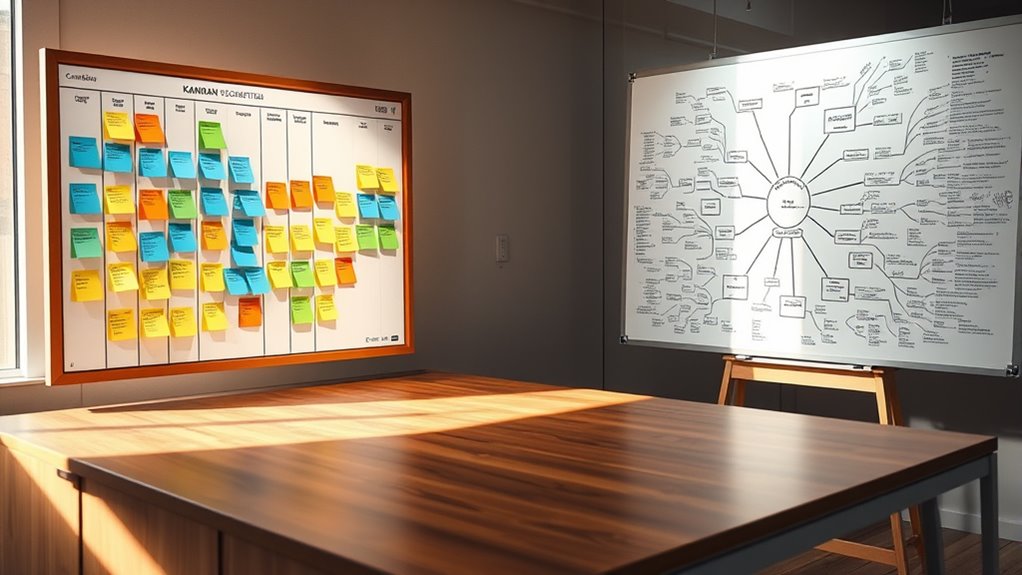To turn failure into fuel, start by reframing setbacks as opportunities for growth and learning, not reflections of your worth. Practice self-compassion to manage emotional setbacks and view failures as valuable feedback that guides your next move. Cultivate a growth mindset by focusing on your purpose and staying motivated through meaningful goals. Consistently reflect and prepare for challenges, knowing setbacks are part of your journey. Stay committed—more strategies to harness failure’s power await if you continue exploring.
Key Takeaways
- Reframe failure as valuable feedback to promote a growth mindset and reduce fear.
- Practice self-compassion to maintain motivation and prevent harsh self-criticism during setbacks.
- Connect setbacks to your broader purpose to foster resilience and sustained effort.
- Use regular reflection and celebrate small wins to strengthen mental toughness and positive outlooks.
- Prepare for challenges by developing resilience strategies that turn obstacles into opportunities for growth.

Failure often feels like a setback, but it can actually be the spark that ignites your greatest achievements. When you experience failure, your instinct might be to retreat or dwell on what went wrong. Instead, you need to reframe this experience through mindset shifts that turn setbacks into stepping stones. Recognize that failure isn’t a reflection of your worth but a essential part of growth. By shifting your perspective, you start to see failures as opportunities to learn and adapt, rather than as definitive endpoints. This change in mindset is *crucial* because it influences how you approach challenges moving forward.
Failure is a chance to learn and grow, not a reflection of your worth or an end.
To effectively turn failure into fuel, you must develop resilience strategies that help you bounce back faster and stronger. Resilience isn’t just about enduring hardship; it’s about actively responding and growing from it. One key strategy is to practice self-compassion. When things go wrong, avoid harsh self-criticism. Instead, speak to yourself with kindness and understanding—remind yourself that everyone faces setbacks and that these don’t define your future. This mental shift reduces the emotional weight of failure and keeps you motivated.
Another resilience strategy involves reframing your failures as data points rather than dead ends. Instead of seeing failure as proof of inadequence, view it as valuable feedback. Ask yourself what lessons can be learned and what adjustments are necessary. This approach not only diminishes fear of failure but also encourages a growth mindset, where challenges are seen as opportunities to improve. As you internalize these mindset shifts, you’ll become more comfortable taking risks, knowing that setbacks are simply part of the process.
Furthermore, cultivate a sense of purpose linked to your goals. When you understand why you’re pursuing something meaningful, setbacks become less discouraging—they become temporary hurdles to overcome. Maintaining this focus helps you stay resilient because your motivation isn’t solely dependent on immediate success. Instead, it’s rooted in your broader vision.
Finally, embrace consistency in your resilience practices. Regularly reflect on your progress, celebrate small wins, and remind yourself of past successes. These habits reinforce your mental toughness and help you develop a resilient mindset that sees failure not as an end but as a necessary chapter in your story of growth. Additionally, understanding potential regulatory compliance challenges can prepare you to navigate setbacks more effectively in professional contexts. With the right mindset shifts and resilience strategies, you’ll find that failure fuels your drive, pushes you to innovate, and ultimately leads to even greater success.
Frequently Asked Questions
How Does the Brain Process Failure at the Neural Level?
When you experience failure, your brain processes it through neural adaptation, which helps your neural circuits adjust to new information. This involves synaptic strengthening, where connections between neurons become more robust as you learn from mistakes. Your brain fundamentally rewires itself, promoting resilience and growth. By understanding this, you can see failure as an indispensable part of neural development, fueling your motivation to improve and succeed.
Can Failure Be Beneficial for Long-Term Brain Development?
Failure can be beneficial for your long-term brain development by fostering a growth mindset and emotional resilience. When you view setbacks as learning opportunities, your brain forms new neural connections, strengthening adaptability. Embracing failure helps you develop resilience, making you more equipped to handle future challenges. Over time, this mindset encourages continuous growth, enhancing cognitive flexibility and emotional strength, ultimately fueling your personal and professional development.
What Role Do Neurotransmitters Play in Overcoming Failure?
Imagine your brain as a superhero fighting setbacks—neurotransmitters are its mighty sidekicks. They play a vital role in overcoming failure through neurotransmitter modulation, boosting your mood and focus. By regulating emotional responses, they help you stay resilient. This chemical teamwork enhances emotional regulation, turning each failure into a stepping stone. Your brain’s ability to adapt hinges on these tiny messengers, empowering you to bounce back stronger every time.
How Can Neuroplasticity Help Reframe Failure as Success?
Neuroplasticity allows you to rewire your brain, enabling mindset shifts that turn failure into success. By actively engaging in resilience building, you can strengthen neural pathways associated with growth and learning. When you view setbacks as opportunities to adapt and improve, your brain rewires itself for persistence. This process helps you develop a positive outlook, making failure a stepping stone rather than a obstacle, fostering long-term success.
Are There Specific Brain Regions Involved in Learning From Failure?
You should know that learning from failure involves specific brain regions like the prefrontal cortex, which helps with emotion regulation, allowing you to manage disappointment. The reward pathways, including the nucleus accumbens, also play a role by reinforcing the motivation to improve. These regions work together, helping you process setbacks, adapt, and turn failure into a learning experience that fuels future success.
Conclusion
Remember, failure isn’t a dead end but a stepping stone carved with lessons. Like a blacksmith forging steel, you transform setbacks into strength, shaping a resilient mind and a brighter future. Embrace each stumble as fuel, igniting your inner fire to push forward. With every fall, you’re not losing ground—you’re building a foundation of wisdom that propels you higher. Keep turning failures into your fiercest allies, and watch your potential soar beyond the skies.








